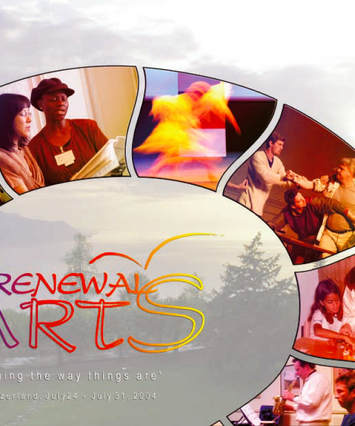The Kutlacas play the harpsichord in turns--Frescobaldi, Scarlatti, Couperin--then they play together, three hands.
HARMONY AND AGONY
Svetlana and Maja Kutlaca, mother and daughter from Serbia, give a harpsichord lecture recital at last July's Renewal Arts Forum at the Initiatives of Change centre in Caux. Svetlana traces the history of ideas about harmony from the Crusades to the French Revolution. She draws on the contribution made by Greek, Arab, Byzantine and Renaissance European thinkers. The Kutlacas play the harpsichord in turns--Frescobaldi, Scarlatti, Couperin--then they play together, three hands. Maja says she is lucky--she only has to use her right hand. They play beautifully.
Meanwhile Zuriah Aljeffri from Malaysia projects slides of her paintings. Among them is a highly acclaimed series which evokes the agony of Bosnia in the 1990s.
KHASI COMEBACK
Khasi musicians and singers from Shillong in north-east India tell me that they are grateful for the Welsh missionaries who in the 1880s brought the Gospel and education to their people. However, they also suppressed the Khasi language and culture. The hill people are only now recovering. One example of this progress is Sohlyngngem, a Khasi operetta, composed and directed from the piano by Neil Nongkynrh, with string performers from Britain, a German jazz saxophonist and a Nigerian drummer. Combined with four singers from Meghalaya the effect is stunning.
HAUNTING SOUNDS
The Catholic chapel opposite the front door of the conference centre is the setting for a recital by two remarkable musicians-- Markus Stockhausen from Germany and Tara Bouman from the Netherlands. Markus plays the flugelhorn, the silver trumpet and the piccolo trumpet; Tara the clarinet, bass clarinet and the basset horn. (No--not all at once.) They play their own compositions and improvisations. The close blending of the haunting sounds, that echo around the high ceiling of the chapel, reflects the closeness of their relationship--they are husband and wife. Their young son in the front pew earns the occasional wink from his mother. As we leave he is at a table, selling their CDs. A harmonious family.
<photo width='200'>2935</photo>
ORIGAMI MARATHON
The Origami workshop, led by three women from Japan in traditional dress, is supposed to meet from 9 to 11 each morning. I look in at 8pm and it is still going strong. Not a Japanese lady in sight. Laura Noble, 11, from England is doing the teaching. The women have not only taught Laura well, they have also been generous with the special Origami paper. Despite the long hours of usage it doesn't run out. How did they have room for anything else in their suitcases, one wonders?
INDIVIDUALS MATTER
Why did Russian theatre director Viatcheslav Dolgachev bring an American play, Twelve Angry Men, from his New Moscow Drama Theatre to Caux? He replies that he looked for a play that would show that the choice of the individual does matter--set, in this case, in a jury room where the fate of a young man accused of murder is in the balance. To begin with, only one of the eleven jurors has 'reasonable doubt' about the boy's guilt. By the end of the play the figures are exactly reversed -- thanks to the courage of the lone juror. Dolgachev's direction is as tight as a taut wire.
RED THUNDER
On the first evening we are treated to a colourful pageant of Plains Indian dance by the Red Thunder troupe from Alberta, Canada. On the final morning they reappear in entirely different costume to perform two Maori dances from New Zealand. The reason? Their director is Aroha Crowchild, a Maori married to a Plains Indian. Several of her children are among the dancers.
BEGINNINGS
Young German composer Uwe Steinmetz's Genesis combines imagination with vision. His seven movements for strings and wind instruments are preceded by readings from the Qur'an in Arabic, the Bhagavad Gita in Hindi, the Torah in Hebrew and the New Testament in English (no Greek-speaker was available). They tell similar stories. On a screen are projected some of the 137 woodcuts executed by Herman Fechenbachs between 1926 and 1936, before he was forced to flee from Germany. They illustrate the Book of Genesis. The music itself draws on Gregorian chant, Indian ragas and jazz motifs. Several artforms contributing to one powerful experience.
English



